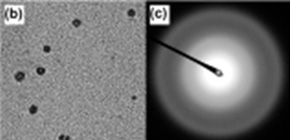
Amorphous nickel nanoparticles' unique catalytic function revealed, a world first
Results will lead to large cost reduction for everyday products
- Graduate School of Engineering Science, Osaka University -- MAJIMA Kazushi (Professor), TSURUGI Hayato (Associate Professor), YURINO Taiga (Specially Appointed Assistant Professor)
- Interdisciplinary Research Center for Catalytic Chemistry, National Institute of Advanced Industrial Science and Technology -- SATO Kazuhiko (Director), TANAKA Shinji (Researcher), SHIMIZU Yoshiki (Chief Researcher, Nanomaterials Research Institute)
A group of researchers generated amorphous nanoparticles of 15 nm in diameter by using cheap and easily available nickel (Ni) for the first time, achieving catalytic C-C bond-forming reactions through the use of these Ni nanoparticles.
Generally, nanoparticles of cheaper and less toxic base metals such as Ni and Fe were difficult to apply to organic synthesis reactions because of their low catalytic activity.
This group's achievement overcame the previously known limitation of catalytic activity of Ni nanoparticles and clarified that Ni can be used for C-C bond-forming reactions as a more active catalyst than nanoparticles of precious metals such as palladium (Pd) and platinum (Pt).
This group's achievement will enable synthesis of conductive polymers and skeletons of medicines at lower prices, which will lead to practical expansion such as drastic cost reduction of OTC drugs.
This group's synthesis technique has enabled them to easily generate particles of metals other than Ni, for example, Fe, copper (Cu), cobalt (Co). Their research results will become the momentum for realizing next-generation materials such as nanomachines and quantum dots, typical applications of metal nanoparticles.
Abstract
A salt-free procedure for the generation of a wide variety of metal(0) particles, including Fe, Co, Ni, and Cu, was achieved using 2,3,5,6-tetramethyl-1,4-bis(trimethylsilyl)-1,4-diaza-2,5-cyclohexadiene, which reduced the corresponding metal precursors under mild conditions. Notably, Ni particles formed in situ from the treatment of Ni(acac) 2 (acac = acetylacetonate) with the reducing reagent in toluene exhibited significant catalytic activity for reductive CC bond-forming reactions of aryl halides in the presence of excess amounts of the reductant. By examination of high-magnification transmission electron microscopy images and electron diffraction patterns, we concluded that amorphous Ni nanoparticles (Ni aNPs) were essential for the high catalytic activity. The Ni aNPs acted as Ni(0) reservoir for the release of catalytically active Ni(0) into the reaction mixture.
Figure 1. Catalytic activity of amorphous nickel nanoparticles (Ni aNPs) for C—C bond forming reaction. It has revealed that the Ni aNPs is more efficient catalyst than palladium and platinum in the same reaction condition.
Figure 2.
- (a) Preparation of Ni a NPs by organosilicon reducing reagent 1 and Ni(acac) 2
- (b) Observation of the Ni a NPs (15 nm) by high-magnification transmission electron microscopy.
- (c) Transmission electron diffraction patterns of the Ni a NPs
Figure 3. Catalytic activities of Ni a NPs and Ni c NPs for Ullmann coupling reaction
Figure 4. The specific character of Ni a NPs: a reservoir of Ni(0).
Figure 5. The role of Ni a NPs catalyst in the reaction cycle
Figure 6. Formation of diaryl methanol derivatives catalyzed by Ni a NPs
To learn more about this research, please view the full research report entitled “ Salt-Free Reduction of Nonprecious Transition-Metal Compounds: Generation of Amorphous Ni Nanoparticles for Catalytic C–C Bond Formation ” at this page of the S cientific Reports website.
Related link



